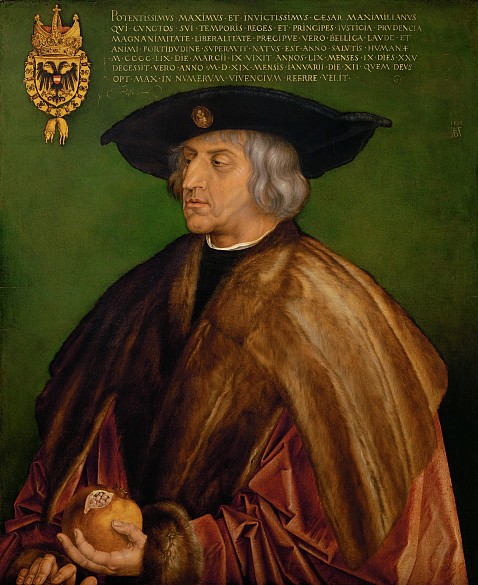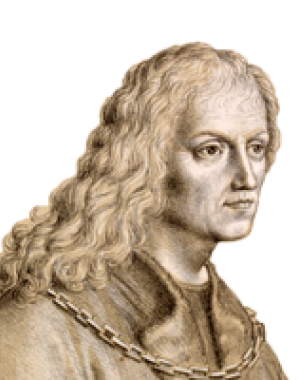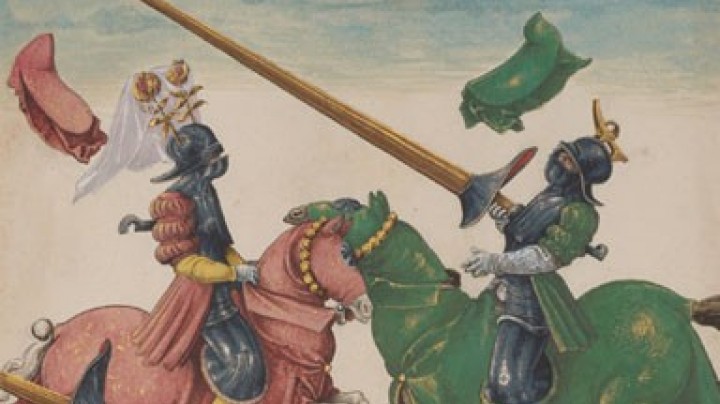Maximilian I as ruler of the Habsburg Hereditary Lands and emperor of the Holy Roman Empire
Maximilian united the possessions of all the Habsburg dynastic lines in his person. The Austrian patrimonial lands formed the solid basis for the emperor’s ambitious politics of Empire.
Maximilian’s father, Frederick V from the Styrian line of the dynasty, had claimed the inheritance of the Austrian line, and in 1490, as successor to Duke Siegmund, Maximilian was able to unite Tyrol and the Forelands with the rest of the patrimonial dominions.
The same year saw the death of Matthias Corvinus, Frederick’s long-standing enemy. To his father’s immense joy, Maximilian was able to re-establish Habsburg dominion over Vienna and Lower Austria, which had fallen to the Hungarian monarch in 1485. A military advance into Hungary in 1490/91 had little immediate consequence but demonstrated the new-found sense of dynamism in the dynasty. Despite older genealogical claims on Bohemia and Hungary, the two crowns went to the Polish-Lithuanian Jagiello dynasty. In compensation for these claims, the Treaty of Pressburg in 1491 gave Maximilian the pledge of a number of territories in western Hungary (present-day Burgenland) together with the guarantee that if the Jagiellos were to become extinct he would inherit the two crowns. This represented the first step towards the Habsburg-Jagiello double marriage of 1515.
Maximilian’s reign also saw the expansion of Habsburg dominion in terms of the gradual acquisition of territories in the county of Gorizia around 1500. The last prince of the Meinhardiner dynasty, Leonhard of Gorizia, concluded a contract of inheritance with the Habsburgs that enabled them to take over large parts of present-day Upper Carinthia and eastern Tyrol together with the Puster Valley in southern Tyrol and territories in the present-day border area between Italy and Slovenia (Gorizia, Gradisca d’Isonzo, Flitsch-Tolmein). The Habsburg’s strengthened position in this region led to conflict with Venice, as the mercantile republic was a powerful rival for influence on Friuli and the northern Italian Alpine region. Further territorial acquisitions included regions in northern Tyrol with Kufstein, Rattenberg and Kitzbühel, together with the area around the Mondsee which Maximilian had claimed in his conflict in the hereditary succession in the Wittelsbach dynasty.
As ruler over the hereditary lands, Maximilian initiated administrative reform, focusing in particular on the financial and juridical sectors. This saw the creation of the first administrative apparatus in these lands that was staffed by a bureaucracy and not as heretofore by functionaries from the ranks of the aristocracy and the Estates. Maximilian took his model from Burgundy, where he had been impressed by the effectiveness of a streamlined and strictly hierarchical administration.
Maximilian planned to execute similar measures that were intended to strengthen the authority of the emperor in the Empire. He was attempting to limit the centrifugal forces in the structure of the Empire and to form closer ties between the imperial princes and the emperor and the Empire. However, here he met with increased resistance and was only able to implement a part of his plans. The result was a long-drawn-out conflict between the emperor and the imperial Estates and the princes of the Empire. Maximilian was soon forced to concede the limits of his power, and as a consequence increasingly devoted his efforts to strengthening his position in the patrimonial dominions.
One lasting result of his attempts to reform the Empire was the introduction of new administrative institutions. The Empire was divided into six (later ten) districts representing a new regional administrative tier to facilitate the levying of taxes demanded by the Empire, the implementation of decrees issued by imperial bodies and the raising and remuneration of imperial military contingents.
The Imperial Court (Reichskammergericht) was also initiated by Maximilian and arose from the negotiations for the ‘Eternal Peace’ at the Diet of Worms in 1495, which brought a ban on feuding. It also created a forum in which conflicts between the imperial Estates could be resolved.














